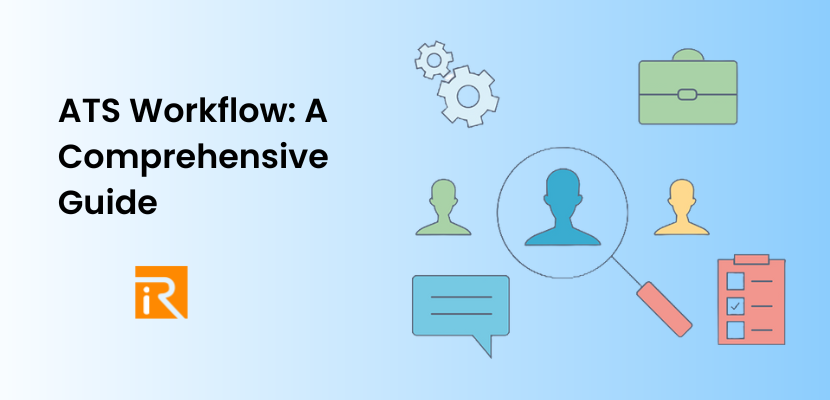Streamlining the hiring process is crucial for organizations of all sizes. One of the most effective tools for achieving this is the ATS workflow.
In this blog post, we’ll explore the ATS workflow, its benefits, and how you can optimize it for better hiring outcomes.
What is an Applicant Tracking System (ATS) Workflow?
ATS stands for Applicant Tracking System, and an ATS workflow refers to the process by which an organization uses an ATS to manage and streamline its recruitment and hiring activities. An ATS is a software application that helps employers collect, organize, and manage job applications and candidate data. It is commonly used by businesses and HR departments to automate and simplify the hiring process.
Key Components of An ATS Workflow
The specific workflow may vary depending on the organization’s needs and the capabilities of the ATS software in use. ATS workflows aim to streamline and automate various aspects of recruitment, making it more efficient and helping organizations find and hire the right candidates for their job openings.
-
Job Posting
The workflow often begins with creating and posting job openings on various job boards, the company website, and other relevant platforms. The ATS can assist in creating and distributing job postings.
-
Application Submission
Candidates submit their applications and resume through the various channels where the job is posted. The ATS collects these applications and stores them in a centralized database.
-
Resume Parsing
The ATS may use a feature called resume parsing to extract important information from resumes, such as contact details, skills, work experience, and education, and populate the candidate profiles in the system automatically.
-
Screening and Filtering
HR professionals and recruiters use the ATS to screen and filter candidates based on specific criteria, such as qualifications, experience, and keywords. This helps in narrowing down the candidate pool to those who meet the job requirements.
-
Candidate Communication
The ATS facilitates communication with candidates by sending automated emails or messages, scheduling interviews, and keeping candidates informed about the status of their applications.
-
Interview Scheduling
The system may offer scheduling tools to help HR teams and candidates arrange interviews more efficiently, reducing scheduling conflicts and coordination efforts.
-
Collaboration and Evaluation
ATS systems often allow multiple team members to collaborate on candidate evaluations. They can leave comments, score candidates, and provide feedback within the system.
-
Background Checks and Reference Checks
Some ATS systems integrate with background check and reference check services, streamlining the verification process for selected candidates.
-
Offer Management
ATS systems can assist in creating and managing job offers, including salary negotiations, offer letters, and tracking candidate responses.
-
Onboarding
Some ATS solutions offer features for onboarding, helping new hires complete necessary paperwork and training materials.
-
Reporting and analytics
Teams can use ATS-generated reports and analytics to assess the effectiveness of their hiring processes, track key metrics, and make data-driven decisions for improving recruitment strategies.
-
Data Security and Compliance
ATS systems typically prioritize data security and compliance with relevant regulations (e.g., GDPR, EEOC). They may include features for data encryption, access control, and audit trails.
Understanding the ATS Workflow
The ATS workflow consists of several key stages that guide the hiring process:
Resume Submission
Job Seeker Engagement: Candidates submit their resumes and applications seamlessly through the company’s career portal or popular job boards.
Standardized Format: Resumes are often transformed into a standardized format for simplified processing, ensuring consistency.
Resume Parsing
Data Extraction: The ATS efficiently extracts critical information from resumes, including contact details, work history, and skill sets.
Candidate Profiles: This parsed data is skillfully utilized to create comprehensive candidate profiles within the ATS system.
Applicant Screening
Precise Filtering: The system employs predefined criteria to filter and rank applicants based on qualifications and suitability precisely.
Time Savings: Recruiters can swiftly identify and focus on the most promising candidates, conserving valuable time and effort.
Interview Scheduling
Streamlined Coordination: ATS systems often offer integrated scheduling tools, allowing recruiters to effortlessly coordinate interviews with selected candidates.
Timely Reminders: Automated reminders ensure that interviews are scheduled, preventing any potential oversights.
Communication and Collaboration
Seamless Interaction: ATS platforms facilitate seamless communication between recruiters, hiring managers, and candidates.
Collaborative Features: Team members can efficiently share feedback, notes, and evaluations, fostering effective collaboration throughout the hiring process.
By comprehending the intricacies of the ATS workflow, organizations can harness its capabilities to streamline recruitment, save time, and enhance collaboration, ultimately leading to more successful hires.
Tips for Optimizing the ATS Workflow
By implementing these ATS workflow optimization strategies, you can streamline your recruitment process, enhance candidate matching, and stay ahead in the competitive talent acquisition landscape.
Keywords Matter
Utilize Relevant Keywords: Incorporate industry-specific and job-relevant keywords in both your job postings and resumes.
Boost Matching Accuracy: These keywords enable the ATS to match candidates more accurately to your job openings.
Customization is Key
Tailor Your ATS: Customize your ATS to align with your organization’s unique hiring requirements and workflow.
Streamlined Process: Personalizing the ATS ensures a smoother and more efficient recruitment process.
Mobile Accessibility
Embrace Mobile-Friendliness: Ensure your ATS platform is mobile-accessible to attract a broader range of candidates.
Wider Applicant Pool: Mobile accessibility allows candidates to apply easily on the go, increasing applicant diversity.
Training Your Team
Practical ATS Usage: Provide comprehensive training for your hiring team on how to proficiently navigate and leverage the ATS.
Maximizing Benefits: Proper training equips your team to harness the full potential of the ATS for better hires.
Regular Updates
Stay Current: Keep your ATS software up-to-date to access the latest features, improvements, and security patches.
Enhanced Functionality: Regular updates ensure your ATS remains effective and aligned with evolving recruitment needs.
Conclusion
An Applicant Tracking System can be a game-changer for your recruitment process. By understanding the workflow and following optimization tips, you can make the most of this technology, saving time, improving candidate quality, and ultimately making better hiring decisions. Start streamlining your hiring process today with a robust ATS.

















